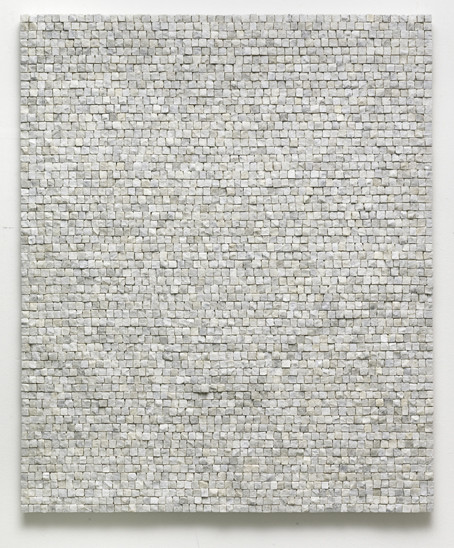Thilo Heinzmann
13 Sep - 25 Oct 2014
THILO HEINZMANN
You It & I
13 September – 25 October 2014
dépendance is pleased to annouce You It & I, Thilo Heinzmann’s third show in the gallery.
This exhibition brings together the rich spectrum of Heinzmann’s art, which since his earliest works from the mid-nineteen-nineties, might be seen as pioneering exploration of the nature and capacities of painting.
‘Heinzmann is a painter in the emphatic sense of the word, fully invested in reinventing and recalibrating that medium’s capacities, while keeping a keen eye on that artform’s rich history. One of the central tenets of Heinzmann’s work lies in revisiting painting’s Western tradition with both of its prime historical momentums in view: painting as the superior medium for showing the world; and, after it had achieved its momentous triumph in retreating to its own means, painting as the field for a powerful interaction of form, color, texture, surface, after the rupture of abstraction. Heinzmann’s work revisits this epochal break and harnesses it into a dichotomy that his art elegantly puts into play.
His works with pigment, for example, display that powdery dust, they exhibit it in its material concreteness, as one of the many specimens of matter that make up our world; but they also transform it into chromatic fields, exploring its wide yet subtle palette, letting color perform as it should after it has been freed of the burdens of representation.
What matters here is, in other words, that what has been influentially described as painting’s ‘Task of Mourning’ (Yve-Alain Bois), or its various endgames, are, in Heinzmann’s work, combined and in that combination release a new productivity. Many ends of painting have been called: showing the world, displaying pure form or color among them. Heinzmann’s paintings make the case that neither end is finite, and that this artform can powerfully deliver its riches when holding both options in balance, and turning that balance into a play that makes for modulation of and meditation on painting’s capacities.
This is particularly visible in Heinzmann’s reinvention of the painter’s gesture.
Formerly, that term referred to the movement with which the hand, via the brush, applied color to the canvas. In his work, Heinzmann offers so many variations of that operation: a caressing move with the hand through a fresh field of oil-paint; a trace of pigment, carried by the movements of air onto a treated surface; or even a series of slender perforations of an aluminum sheet, named Aicmo. All of these are recognizable as reconsiderations and reinventions of that fundamental movement, choreography, swift or slow application, through which the artwork of painting comes into being.’
You It & I
13 September – 25 October 2014
dépendance is pleased to annouce You It & I, Thilo Heinzmann’s third show in the gallery.
This exhibition brings together the rich spectrum of Heinzmann’s art, which since his earliest works from the mid-nineteen-nineties, might be seen as pioneering exploration of the nature and capacities of painting.
‘Heinzmann is a painter in the emphatic sense of the word, fully invested in reinventing and recalibrating that medium’s capacities, while keeping a keen eye on that artform’s rich history. One of the central tenets of Heinzmann’s work lies in revisiting painting’s Western tradition with both of its prime historical momentums in view: painting as the superior medium for showing the world; and, after it had achieved its momentous triumph in retreating to its own means, painting as the field for a powerful interaction of form, color, texture, surface, after the rupture of abstraction. Heinzmann’s work revisits this epochal break and harnesses it into a dichotomy that his art elegantly puts into play.
His works with pigment, for example, display that powdery dust, they exhibit it in its material concreteness, as one of the many specimens of matter that make up our world; but they also transform it into chromatic fields, exploring its wide yet subtle palette, letting color perform as it should after it has been freed of the burdens of representation.
What matters here is, in other words, that what has been influentially described as painting’s ‘Task of Mourning’ (Yve-Alain Bois), or its various endgames, are, in Heinzmann’s work, combined and in that combination release a new productivity. Many ends of painting have been called: showing the world, displaying pure form or color among them. Heinzmann’s paintings make the case that neither end is finite, and that this artform can powerfully deliver its riches when holding both options in balance, and turning that balance into a play that makes for modulation of and meditation on painting’s capacities.
This is particularly visible in Heinzmann’s reinvention of the painter’s gesture.
Formerly, that term referred to the movement with which the hand, via the brush, applied color to the canvas. In his work, Heinzmann offers so many variations of that operation: a caressing move with the hand through a fresh field of oil-paint; a trace of pigment, carried by the movements of air onto a treated surface; or even a series of slender perforations of an aluminum sheet, named Aicmo. All of these are recognizable as reconsiderations and reinventions of that fundamental movement, choreography, swift or slow application, through which the artwork of painting comes into being.’

